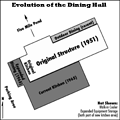The Dining Hall
At the top of "The Hill", with a great view of Five Mile Pond below, is a building that just about anyone who's ever spent a week of summer camp at Cachalot is sure to recognize–the Dining Hall, our dining facility and more. Whether the occasion has been Sunday dinner, a Lodge Officer Training, a Klondike closing ceremony, a crackerbarrel, or even the occasional flooded-out Camp-o-ree, you've probably spent a little bit of time in the dining hall.
That is, provided you've been to camp since 1950. For the first 5 years of operation (1946-1950) there was no building to house the kitchen; instead, there was a collection of military-style canvas tents set up on wooden platforms for your dining convenience. The Dining Hall was completed just in time for the 1951 season of summer camp, and was a big enough addition that it merited coverage in the New Bedford Standard-Times:
Big news at Camp Cachalot is a newly-constructed mess hall; high upon the pine-studded hilltop over the waterfront. Completed just in time for the camp season, the structure resembles a large modern log cabin and is constructed of sturdy tight-grained wood. - Standard-Times, August 15th, 1951, p 13.
The article goes on to note that the kitchen had not yet been completed, as the Council was still in the process of bringing electric power into camp. The electric service, and the kitchen, were expected to be complete in the fall.
The original structure was a bit smaller than today, a nearly L-shaped building with the kitchen at the end facing what is today the parking area. The building escaped serious damage in the fire of 1964, but part of the reconstruction effort put money towards expanding the building. By the summer of 1966, the kitchen had been relocated to a new addition on the side of the building facing the road, and the old kitchen area was added on to, increasing the size of the dining area significantly. Later additions in the early 1990's and 2000's added a larger walk-in cooler and an expanded equipment storage area to the kitchen, respectively. Most recently, an covered outdoor dining area on the side facing Five Mile Pond was added, and is a popular dining spot in the summer.
There's long been a tradition of hanging plaques in the open rafters of the Dining Hall to memorialize your Troop's or Patrol's week at summer camp. Plaques currently hanging in the rafters date from the 1950s all the way through last summer, and feature everything from simple one-color wooden plaques listing the members of a unit all the way through elaborately painted, carved, and crafted masterpieces of wood, cloth, rope, and metal. Check out the pictures accompanying this article for one well-known example. In addition to all of the unit plaques, the kitchen wall is a repository of many of the bronze plaques saved from Camp Noquochoke, and the underside of the roof sheathing is scrawled with the names of dozens of former kitchen staffers.
The building is currently in good condition, although there's always a little work to be done. The Alumni Association gave the building a fresh coat of stain in 2005, and that's holding up well. The window shutters will likely need some work in the next few years, and, unfortunately, the fireplace is all but unusable in its current condition (not that it ever stood a chance of warming more that the people directly in front of it to begin with.) The ambience it once provided is missed.
The summer of 2006 marked the Dining Hall's 55th birthday, and as in summers past, it was used by Scouts and Scouters by the table-load, and filled to the rafters with song at least a few times every day. They dined on the finest Camp cuisine (it really is better than you remember it, not that it was ever that bad to begin with...), and listened to all those important announcements (announcements, announcements, please!) that came with a day in camp. At the end of their week some of them even added a little bit more to the history of the place with their own plaques. Here's hoping it continues to be a center of fellowship for many more years to come!
All content copyright ©2004- by the Camp Cachalot Alumni Association, except where otherwise noted.
This page was last modified on Wed Dec 19th 2007.
Site look odd? Your browser may not be up to date. See the note on the main page.


